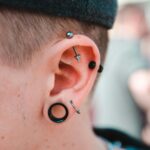Welcome to the world where light, creativity, and stunning visuals collide! If you’ve ever marveled at those breathtaking photos that radiate warmth and evoke emotion with their dreamy lens flares, you’re in for a treat. In this comprehensive guide to Photeeq Lens Flare, we’ll delve into the art of harnessing this mesmerizing effect, transforming ordinary images into extraordinary pieces of visual storytelling. Whether you’re a seasoned photographer or just starting your creative journey, discover how to master lens flare techniques that can elevate your work from good to unforgettable. Grab your camera and get ready—let’s illuminate your photography skills like never before!
Introduction
Have you ever gazed at a photograph and felt an instant connection, captivated by the ethereal glow that dances through the image? That mesmerizing effect often stems from lens flare—a phenomenon that photographers have harnessed to create stunning visual narratives. Enter photeeq lens flare: your new secret weapon for adding depth, emotion, and drama to your shots. Whether you’re a seasoned pro or just dipping your toes into photography, understanding how to use this powerful technique can elevate your work. Let’s dive deep into the world of photeeq lens flare, exploring its nuances and unleashing its potential in your creative endeavors.
Understanding the basics of lens flare and how it affects photos
Lens flare occurs when light hits the lens directly, creating bright spots or streaks in an image. This phenomenon often happens in high-contrast situations, such as shooting into the sun.
The effect can add a dreamlike quality to photos, infusing them with warmth and depth. However, it can also distract from your subject if not controlled properly.
Understanding how lens flare behaves is essential for photographers. It interacts with different lenses uniquely and varies based on aperture settings.
Photographers may embrace this natural occurrence for creative expression or aim to minimize its impact depending on their vision for the shot. Knowing when and how to use lens flare effectively opens up new possibilities in your photography toolkit.
Different types of lens flare and their characteristics
Lens flare can manifest in various forms, each with its own unique visual appeal. One common type is the “ghosting” effect, where multiple light sources create circular artifacts that mimic halos around bright highlights.
Another characteristic is the “starburst” flare. This occurs when points of light radiate sharp lines toward the edges, adding a dramatic flair to images, especially during golden hour.
You might also encounter “color fringing,” where flares introduce vibrant hues along the edges of objects. These vivid splashes can enhance an image’s mood and depth.
Lastly, there’s the classic “veiling glare.” It softens overall contrast and adds a dreamy quality to photos by creating a hazy wash over details. Each type offers distinct possibilities for artistic expression in photography.
Tips for creating intentional lens flare in your photos
Creating intentional lens flare can add a dreamy quality to your photos. Start by positioning the light source strategically. Backlighting is your friend; place the sun or another bright light just outside the frame for that perfect glow.
Experiment with different angles. Tilt your camera slightly and watch how the light interacts with your lens. Sometimes, a small shift can create stunning effects.
Use a wide aperture to enhance the flare’s intensity. A lower f-stop will not only let in more light but also help isolate subjects against that beautiful backdrop of color.
Consider using filters as well. A graduated neutral density filter can balance exposure while allowing for creative flaring without overexposing other areas of your image.
Finally, don’t be afraid to play around in post-processing! Adding slight enhancements digitally can elevate those natural flares into captivating elements of storytelling within your photography.
How to avoid unwanted lens flare in your photos
Unwanted lens flare can disrupt your photos, making them appear hazy or washed out. To prevent this, start by using a lens hood. This simple accessory blocks stray light from hitting the lens directly.
Pay attention to lighting angles as well. Position yourself so that the sun or bright lights are not in direct line with your camera’s lens. Experimenting with different angles can help you find sweet spots free of flare.
If you’re shooting in strong sunlight, consider adjusting your aperture settings. A smaller aperture often reduces flaring effects and enhances sharpness.
Lastly, regularly clean your lenses. Dust and smudges can amplify unwanted glare and reduce clarity in images, leading to more pronounced flare issues than necessary. Keeping your gear spotless is an easy yet effective preventive measure for clearer photographs.
Editing techniques to enhance or remove lens flare in post-processing
Editing lens flare in post-processing can transform your images. If you want to enhance the effect, use software like Adobe Lightroom or Photoshop. Increase contrast and saturation around the flare for a more dramatic look.
For those who wish to remove lens flare, start with the healing brush tool. Carefully paint over unwanted areas to blend them seamlessly into the background.
Another option is using adjustment layers. This allows for selective editing without altering your original photo permanently. You can darken specific areas where glare distracts from the subject.
Consider utilizing gradient filters as well. They help control brightness levels and can soften harsh flares without losing detail in other parts of your image.
Experimenting with opacity settings on layers gives you flexibility too. Adjust until you achieve a balance that feels right while maintaining natural aesthetics in your photography.
Examples of stunning photos using lens flare
Lens flare can transform an ordinary photograph into something extraordinary. Consider a portrait shot at sunset, where rays of light dance around the subject’s hair. This creates a magical halo effect that adds depth and emotion.
In landscape photography, lens flare enhances natural beauty. Picture a serene mountain scene with sunlight peeking through trees, casting warm glows over the peaks. It evokes feelings of tranquility and adventure.
Candid street photography also benefits from intentional lens flare. Imagine capturing a bustling market under bright midday sun, with vibrant colors amplified by flares penetrating the frame. This approach adds dynamic energy to everyday moments.
Weddings are another venue for stunning lens flare usage. A couple bathed in golden hour light surrounded by soft flares offers romantic imagery that feels ethereal and timeless.
Each example showcases how photeeq lens flare elevates visual storytelling across diverse genres in photography.
Creative ways to incorporate lens flare into your photography style
Lens flare can add a unique touch to your photography. Experiment with different light sources, like the sun or street lamps, to create dynamic effects. Position yourself at various angles to capture how light interacts with your lens.
Try using filters or props. A prism can scatter light and introduce colorful flares that complement your subject beautifully. This technique adds an artistic flair that’s hard to replicate.
Consider shooting during golden hour for softer sunlight. The warm tones enhance the mood of your images while introducing gentle flares around edges.
Don’t shy away from incorporating foreground elements. Tree branches or buildings can frame the light, guiding viewers’ attention toward the main subject.
Lastly, explore post-processing options in software like photeeq. Subtle adjustments can amplify existing lens flare effects or even bring out new ones you didn’t capture initially.
Common misconceptions about lens flare
Many photographers believe that lens flare is always a mistake. This misconception overlooks the artistic potential of intentional flare in images.
Another common myth is that only specific lenses produce this effect. In reality, any lens can create flare under the right conditions; it often depends on light sources and angles.
Some assume that lens flare diminishes image quality. While excessive or distracting flares can be problematic, a well-placed flare adds depth and character to photos.
Lastly, some think post-processing can completely eliminate natural lens flare without consequence. However, removing it entirely may strip away layers of emotion and story within an image.
Understanding these misconceptions opens doors for creative experimentation with photeeq lens flare in your photography journey.
Conclusion
Embracing photeeq lens flare can transform your photography journey in unexpected ways. This unique effect adds a layer of emotion and depth to your images, inviting viewers into the moment captured. Whether you’re shooting landscapes during golden hour or experimenting with portraits, intentional lens flare can create a striking visual narrative.
Remember that each type of lens flare has its own characteristics and mood. Learning how to manipulate these light artifacts allows you to express creativity in every shot. With practice, you’ll discover the delicate balance between utilizing flares for artistic flair while minimizing unwanted distractions.
As you explore this fascinating technique, allow yourself the freedom to experiment and play with light. It’s not just about capturing what’s there; it’s about conveying feeling through your work. The beauty of photeeq lens flare lies in its ability to enhance storytelling within an image.
So grab your camera and start embracing this captivating element today! Your photographs might just tell stories you’ve never imagined before.










